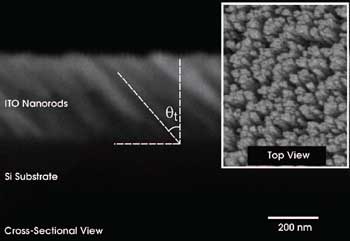Richard Gaughan
The development of GaN-based LEDs has pushed the emission of these solid-state sources into the blue and ultraviolet and has enabled the production of white-light LEDs, promising benefits in terms of device lifetime and energy usage. For white-light LEDs to replace traditional sources in general illumination applications, however, their efficiency must improve.
A new multilayer omnidirectional reflector developed at Rensselaer Polytechnic Institute (RPI) in Troy, N.Y., and at Samsung Advanced Institute of Technology in Suwon, South Korea, is showing potential for improving the extraction efficiency to boost the brightness of LEDs.

Indium-tin-oxide (ITO) nanorods act as an omnidirectional reflector to improve the efficiency of LED output coupling. The porous layer of nanorods has a much lower index of refraction than a solid layer of ITO but still is electrically conductive. The omnidirectional reflector increased the output of a GaN LED by 32 percent. Courtesy of Jingqun Xi.
The omnidirectional reflector can be thought of as a sort of distributed Bragg reflector, a traditional one of which consists of alternating layers of materials with different refractive indices, and the index contrast determines the reflectance and spectral width of the device. In the new reflector, the microstructure of a porous layer of indium-tin-oxide (ITO) nanorods enables it to act as a low-refractive-index layer.
The researchers constructed this layer using oblique-angle electronbeam deposition. With the substrate held at an angle of 80° to the vapor source, natural fluctuations produce bumps in the layer. Each bump creates a preferential deposition zone and a shadowed region, and the result is the growth of a layer composed of ITO nanorods interspersed with elongated air-filled pores.
The microstructure has a considerable effect on the properties of the material. A continuous ITO layer is electrically conductive and has an index of 2.06 at 461 nm. The low-refractive-index nanorod layer retains the electrical conductivity but has an index of 1.34 at 461 nm — lower than that of SiO2, which served as the low-refractive-index layer in previous omnidirectional reflectors.
In a series of recent experiments, the scientists incorporated the reflector into a 474-nm GaInN LED. They deposited a quarter-wave-thick layer of ITO nanorods atop the P-doped GaN contact layer of the LED. The rough surface of the ITO was smoothed with a 20-nm-thick pore closure layer, and a 200-nm layer of silver completed the output reflector. The enhanced reflectivity and lower losses in the waveguide modes yielded a 32 percent increase in output power in devices with the low-refractive-index nanorod layer relative to those without it.
The process is not restricted to ITO, said E. Fred Schubert, a professor at RPI, noting that alternating layers of low-refractive-index SiO2/TiO2 nanorods are of interest for efficient distributed Bragg reflectors. Additional applications of the new class of materials include their use in coatings, filters and resonant cavities.
Applied Physics Letters, Jan. 2, 2006, 013501.